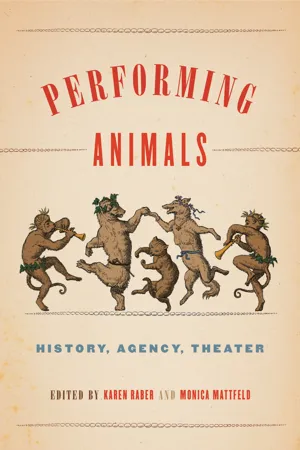
Animalibus
Of Animals and Cultures
- English
- PDF
- Available on iOS & Android
About This Book
From bears on the Renaissance stage to the equine pageantry of the nineteenth-century hunt, animals have been used in human-orchestrated entertainments throughout history. The essays in this volume present an array of case studies that inspire new ways of interpreting animal performance and the role of animal agency in the performing relationship.
In exploring the human-animal relationship from the early modern period to the nineteenth century, Performing Animals questions what it means for an animal to "perform, " examines how conceptions of this relationship have evolved over time, and explores whether and how human understanding of performance is changed by an animal's presence. The contributors discuss the role of animals in venues as varied as medieval plays, natural histories, dissections, and banquets, and they raise provocative questions about animals' agency. In so doing, they demonstrate the innovative potential of thinking beyond the boundaries of the present in order to dismantle the barriers that have traditionally divided human from animal.
From fleas to warhorses to animals that "perform" even after death, this delightfully varied volume brings together examples of animals made to "act" in ways that challenge obvious notions of performance. The result is an eye-opening exploration of human-animal relationships and identity that will appeal greatly to scholars and students of animal studies, performance studies, and posthuman studies.
In addition to the editors, the contributors are Todd Andrew Borlik, Pia F. Cuneo, Kim Marra, Richard Nash, Sarah E. Parker, Rob Wakeman, Kari Weil, and Jessica Wolfe.
Frequently asked questions
Information
Table of contents
- COVER front
- Copyright Page
- Table of Contents
- List of Illustrations
- Introduction
- Notes to Introduction
- Chapter 1: Animals at the Table: Performing Meat in Early Modern England and Europe
- Notes to Chapter 1
- Chapter 2: Intra-Active Performativity: Rethinking the Early Modern Equestrian Portrait
- Notes to Chapter 2
- Chapter 3: Past Performances: Gleanings from the Archives About Early Modern Equine Athletic Performance
- Notes to Chapter 3
- Chapter 4: "I See Them Galloping!": War, Affect, and Performing Horses in Matthew Lewis's Timour the Tartar
- Notes to Chapter 4
- Chapter 5: Peaceable Kingdom: The Place of the Dog at the Nativity Scene
- Notes to Chapter 5
- Chapter 6: Performing Pain: The Suffering Animal in Early Modern Experiment
- Notes on Chapter 6
- Chapter 7: Circus Minimus: The Early Modern Theater of Insects
- Notes on Chapter 7
- Chaper 8: Shakespeare's Insect Theater: Fairy Lore as Elizabethan Folk Entomology
- Notes to Chapter 8
- Chapter 9: Miss Mazeppa and the Horse with No Name
- Notes to Chapter 9
- Chapter 10: Horses Queer the Stage and Society of Shenandoah
- Notes to Chapter 10
- Bibliography
- Contributors
- Index
- COVER Back